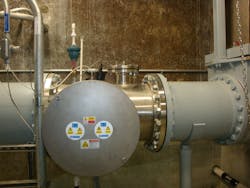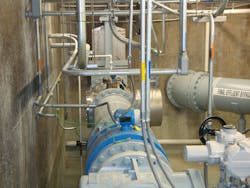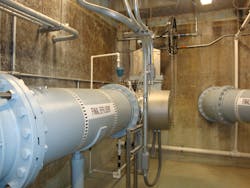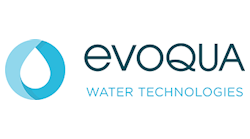As water scarcity becomes a growing issue for communities around the world, water reuse will be more frequently relied upon as an alternative source of drinking water. Therefore, finding a solution for disinfecting wastewater to achieve safe and healthy reusable water for public consumption is of increasing concern. From the water in their taps to the water that nourishes their crops, populations want to be able to trust that this natural resource will maintain their health, not harm it. To meet these expectations, treatment facilities are continuing to improve their recycling technologies to effectively eliminate the variety of contaminants often found in wastewater.
These facilities have already developed very successful ways to neutralize harmful bacteria and viruses, most commonly through chlorine disinfection. Using chlorine to disinfect has many benefits: it is cost effective, very easy to use, relatively safe to handle and store, and — most importantly — is reliable and effective against a wide spectrum of harmful organisms.
But while standard disinfection protocols are effective against standard harmful organisms, those protocols do not adequately combat the rise in chlorine-resistant pathogens — a problem that wastewater treatment facilities must also consider if effective water reuse is to be achieved. As a result, the new standard in wastewater disinfection technologies needs to be that which can combat these pathogens.
The resistant pathogen problem has two facets: pathogens that are resistant to disinfection treatments like chlorine, and the proliferation of antibiotics in both untreated and treated water that are creating new breeds of antibiotic-resistant, disease-causing microorganisms. The CDC estimates that 2.8 million antibiotic-resistant infections occurring each year — E. coli, Klebsiella pneumoniae, Staphylococcus aureus, Enterobacteriaceae and multi-drug resistant tuberculosis — are all now resistant to first line or combination antibiotics due to the addition of antibiotic-resistant genes from other bacterial species that are acquired through horizontal gene transfer.
New technologies and methods are needed to inactivate these pathogens before they cause more widespread issues throughout the water ecosystem. Additionally, these pathogens can continue to spread if they are not eliminated. States that are already upping their reclaimed water regulations to meet the new standard in wastewater disinfection include California, Arizona, Florida, New Mexico, and Colorado. Each is considering a variation of the promising 12/10/10 log reduction standard across the treatment train from untreated wastewater to potable water.
Because these antibiotic-resistant bacteria are byproducts of traditional wastewater treatment methods, more complex solutions are needed to safely oxidize and inactivate them and mitigate their spread. A combination of UV disinfection and ozone, peroxide or chlorine creates an advanced oxidation process (AOP) that can effectively remove concerning contaminants. UV disinfection works by dismantling the DNA (or RNA, in the case of a virus), thereby preventing replication so that these organisms pose no further threat to health. Ozone systems are often incorporated where robust oxidation is required without a persistent chemical residual.
The Rushville Wastewater Treatment Plant in Indiana is one facility that has already made the switch from a chlorine disinfection system to one that employs UV.
The city of Rushville had historically experienced combined sewer overflows (CSOs) in extreme weather. CSOs occur when a city’s wastewater and stormwater drain into the same treatment system, causing the system to become overwhelmed and release untreated wastewater — including all of its contaminants — into the environment. In Rushville’s case, discharges into the Flat Rock River led to Clean Water Act violations, and an agreement between the city and Indiana Department of Environmental Management (IDEM) called for the elimination of CSO discharges within 15 years. Rushville began to reevaluate its treatment protocols accordingly.
Like many municipalities, Rushville had historically relied on a chlorine disinfection system, but restrictive chlorine residual requirements had become difficult for the rural plant to meet.
Rushville realized that a UV system would meet its water treatment needs while also lessening the environmental impact and more effectively eliminating chlorine-resistant pathogens like Giardia and Cryptosporidium. The closed-vessel ETS-UV system that Rushville ultimately chose successfully inactivated those pathogens, is fully capable of responding to variable flow and water quality, and it minimized cost and impact to rate payers through its compact design.
The Rushville UV system was also the first completed project in the United States to combine UV disinfection with cloth-media disk filters (CMDFs) to treat CSOs. The filters served to improve the efficiency of the UV system by reducing the total suspended solids, which can shield pathogens as they pass by the UV light, resulting in an incomplete disinfection. This pairing created a complex solution for treating the wastewater and stormwater entering the plant that was more effective than UV alone.
With this disinfection technology, Rushville is ensuring that reclaiming wastewater continues to be a strategic solution for its community’s water needs while keeping the environmental impacts to the Flat Rock River at a minimum.
The pursuit of clean, potable water from wastewater has become complicated by the presence of increasingly resistant contaminants, thereby raising the standard for effective wastewater disinfection. However, thanks to evolving technologies, there are solutions for eliminating these substances so that wastewater treatment facilities can deliver the safe water supplies their communities expect and deserve. WW
About the Author: Jon McClean is the VP of technology and innovation at Evoqua Water Technologies. He leads technology and innovation applications across Evoqua. He won the prestigious Queen’s Award in 2001 for an innovation in UV technology that is now used globally in the Vanox® AOP process for ultra-pure water.






